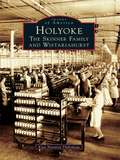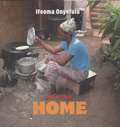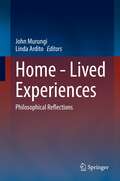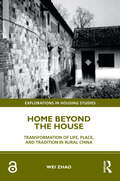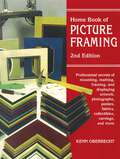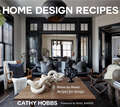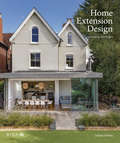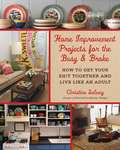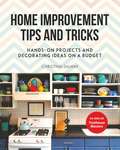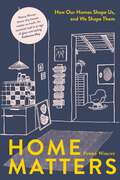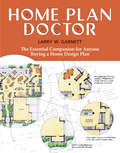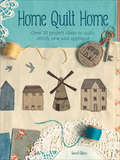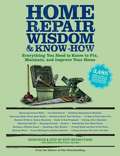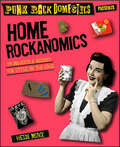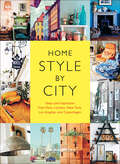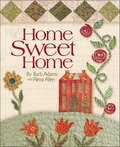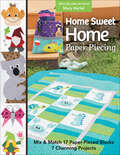- Table View
- List View
Holyoke: The Skinner Family and Wistariahurst
by Kate Navarra ThibodeauBorn in England in 1824, William Skinner was a tradesman who, at 19, immigrated to the United States. Skinner turned his skill and resourcefulness into a tremendous success. He first went to work in Northampton and eventually opened the Unquomonk Silk Mills in nearby Haydenville. Skinner would have remained there had a flood not destroyed his business. He built a new mill along the canals in Holyoke, one of America's first planned industrial cities, and moved his family home, Wistariahurst, to the city by dismantling it piece by piece. Residing in Holyoke for eight decades, the Skinner family contributed greatly to the community. Holyoke: The Skinner Family and Wistariahurst contains a rich legacy of photographs, letters, journals, and oral histories that provide an amazing view into life at Wistariahurst and the adventures of the family and their servants.
Home (Look at This!)
by Ifeoma OnyefuluCooking pot, stool, basket, water pot and sleeping mat... a first words book. Cooking pot, stool, basket, water pot and sleeping mat. . . All kinds of things around the home, with a vibrant mix of Western and traditional African objects. Photographed in Mali by an award-winning photographer, this is a unique and culturally diverse First Words book, with lots to look at and talk about. Also available in the "Look at This!" series: "Food," "Clothes," and "Play." Other books by this author are available in this library.
Home - Lived Experiences: Philosophical Reflections
by John Murungi Linda ArditoThis book explores the lived experience of being at home as well as being homeless. Being at home or not is typically a matter of being at a place or not, where such a place is carved out of space and designated as such. It is a place that is both empirical and trans-empirical. When one is at home or not at home, one typically has in mind an inhabited place. To inhabit or not to inhabit it is to find oneself in a place that has an affective presence or absence. In either case, affectivity points to a lived place where lived experience is constituted and displayed. Thus, in this context, affectivity becomes more than the subject of empirical psychology. If psychology were to have access, it would be in the context of phenomenological or existential psychology – a psychology that has its roots in the sensible world and, hence, a psychology that expresses an aesthetic dimension. Each of the contributors in this book extends an invitation to the readers to participate in constituting, extending, and sharing with others the sense of either being at home or of being homeless. This book appeals to students, researchers as well as general interest readers.
Home Beyond the House: Transformation of Life, Place, and Tradition in Rural China (Explorations in Housing Studies)
by Wei ZhaoBased on extended fieldwork conducted between 2007 and 2019, this book aims to answer a simple question: What is the meaning of home for people living in vernacular settlements in rural China? This question is particularly potent since rural China has experienced rapid and fundamental changes in the twenty-first century under the influences of national policies such as "Building a New Socialist Countryside" enacted in 2006 and "Rural Revitalization" announced in 2018. Drawing upon ethnographic fieldwork, building surveys, archival research, and over 600 photographs taken by residents along with their life stories, this book uncovers the meanings of home from rural residents’ perspectives, who belong to a social group that is underrepresented in scholarship and underserved in modern China. In other words, this study empowers rural residents by giving them voice. This book links the concepts of place, home, and tradition into an overarching argument: The meaning of home rests on the ideas of tradition, including identity, consanguinity, collectivity, social relations, land ownership, and rural lifestyle.
Home Book of Picture Framing
by Kenn OberrechtProfessional secrets of mounting, matting, framing, and displaying artwork, photos, collectibles, carvings, and more.
Home Decor Cheat Sheets: Need-to-Know Stuff for Stylish Living
by Jessica ProbusTHE MOST IMPORTANT CONCEPTS OF HOME DESIGN, DECOR, AND FURNISHING SIMPLIFIED INTO 300 FRIENDLY, EASTY-TO-UNDERSTAND GRAPHICSHome Decor Cheat Sheets shows you the dos, the don&’ts and the timeless design rules for a perfectly coordinated space. These colorful, easy-to-understand illustrations teaching you everything needed to beautifully furnish, arrange and decorate your home. In mere seconds, you&’re able to grasp the vital concepts needed to give your house an inspiring look, including how to:• Properly Match Furniture Styles• Brighten Rooms with Natural Light• Stylishly Arrange Wall Art• Perfectly Fit the Rug to the Room• Create Dramatic Lighting Effects• Add Elegance Using Throw Pillows
Home Decorating For Dummies (General Trade Ser. #178)
by Katharine Kaye McMillan Patricia Hart McMillanWant to be your own decorator? Design on a dime with Dummies! Home Decorating For Dummies packs all the information you need to know about décor into one easy-to-read source. Whether you want to decorate one room or make over the whole house, this book has everything you need to design like a pro. This is the only reference you&’ll need to transform your home into a space you&’ll love. Dummies offers no-nonsense help, so you can plan perfect projects and stay within budget. Updated with the latest on smart homes, short-term rentals, DIY décor, and more. Learn how to optimize your home&’s floor plan Discover tricks for mixing patterns, colors, and textures successfully Refresh your home&’s style without spending a fortune Decorate rental properties with eye-catching, trendy style Untangle the terms—mid-century modern, farmhouse, minimalism—and pinpoint your design styleFor those seeking ideas, resources, and budget-wise tips to spark their decorating creativity, Home Decorating For Dummies is a must-have.
Home Design Recipes: Room by Room Recipes for Design
by Cathy HobbsWelcome to the world of Home Design Recipes – your ultimate guide to modern home design rooms with ease. Just as baking the perfect cake requires sourcing the finest ingredients and following a tried-and-true recipe, designing a stunning space demands the right "ingredients" and a step-by-step plan.Simple home improvement. In this innovative design "cookbook," we demystify the process of interior design, providing you with easy-to-follow recipes for crafting modern, stylish homes. Gone are the days of merely admiring beautiful pictures without understanding how to replicate the look. With Home Design Recipes, you'll be empowered to transform your house design from ordinary to extraordinary. Endless design ideas. Each recipe in this book is meticulously crafted to guide you through the modern home design process, from A to Z. Cathy Hobbs covers essential topics, popular hacks, and trade secrets, offering practical advice and top tips for every step of the journey. Whether you're a seasoned design enthusiast or a DIY newcomer, you'll find inspiration and guidance to elevate your house design. Inside this book, you&’ll find: A go-to resource for all things modern home design A house decorating book that equips you with the knowledge and confidence to create your dream home The courage and confidence to unleash your creativity and design a home that reflects your unique style If you liked The Art of Home, Call It Home, or The New Design Rules, you&’ll love Home Design Recipes.
Home Design With Feng Shui A-Z
by Terah Kathryn CollinsThe quick reference guide that makes Feng Shui easily accessible to everyone! Feng Shui expert Terah Kathryn Collins brings you clear, concise information on how to apply Feng Shui to every room of your home–from your bedroom to your home office.
Home Ec for Everyone: Cooking · Sewing · Laundry & Clothing · Domestic Arts · Life Skills
by David Bowers Sharon BowersDid you remember your scissors?Discover the tremendous pleasure of learning how to do it yourself how to cook, sew, clean, and more, the way it used to be taught in Home Ec class. With illustrated step by step instructions, plus relevant charts, lists, and handy graphics, Home Ec for everyone offers a crash course in learning 118 practical life skills-everything from frosting the perfect birthday cake to fixing a zipper to whitening a dingy T-shirt to packing a suitcase (the right way). It&’s all made clear in plain, nontechnical language for any level of DIYer, and it comes with a guarantee: No matter how simple the task, doing it with your own two hands provides a feeling of accomplishment that no app or device will ever give you.
Home Extension Design
by Julian OwenIf you are thinking of improving your home but want the real story of how to be successful, this richly illustrated and completely up-to-date book is for you. It distils various practical information needed to run a project from dream to reality, highlighting the pitfalls along the way and suggesting ways to avoid them. Peppered with inspirational case studies and giving indications of costs and timescales, Home Extension Design demystifies both the building process and all the surrounding issues to do with design, sustainability, budgeting, planning, regulations and the use of building contracts.The comprehensive guidance includes chapters on making the best of what you've got, designing the changes to your home, types of house alteration projects (including extensions, loft conversions and basements), submitting applications to the local authority, and getting the building work done.
Home Hacks: Handy Hints to Make Life Easier (Life Hacks Ser.)
by Dan MarshallDozens of everyday household dilemmas are solved with HOUSEHOLD HACKS, your handy guide to tackling little domestic annoyances, cheaply and swiftly, so you can get on with something more fun. This fully illustrated manual covers everything from ingenious space-saving storage solutions, clever cleaning hacks, DIY and much, much more.
Home Improvement Projects for the Busy & Broke: How to Get Your $h!t Together and Live Like an Adult
by Monica Pedersen Christina SalwaySearching for a house or apartment is difficult enough on its own-transforming it into your home is an entirely different story, especially for those who have never lived on their own before. As millenials create their first homes away from home, they are bombarded with constant DIY ideas and articles on social media. Unfortunately, many of the seemingly simple ideas are beyond the average twenty-something’s means.Home Improvement Projects for the Busy & Broke aims to give you the knowhow and teach you to decorate your home while staying within your budget, all presented in an engaging and approachable way. Each project is accompanied by a list of tools and materials needed, along with step-by-step instructions. Salway uses her wit and playful personality to describe her journey of renovating and redecorating not only her two-bedroom Williamsburg apartment, but also the New York farmhouse she and her husband bought as a major fixer-upper. Just like millenials today, she took on these projects while working a full-time job and sticking to a strict budget-the advice is tried and true!A resource for anyone who is short on time and strapped for cash, Home Improvement Projects for the Busy & Broke will help you turn any space into a unique home you love and are proud to show off.
Home Improvement Tips and Tricks: Hands-on Projects and Decorating Ideas on a Budget
by Christina SalwayStep-by-Step Projects from a Successful and Sassy Interior Designer!Searching for a house or apartment is difficult enough on its own; transforming it into your home is an entirely different story. Home Improvement Tips and Tricks aims to give you the knowhow to decorate while staying within your budget, all presented in an engaging and approachable way. Each project is accompanied by a list of tools and materials needed, along with step-by-step instructions. Salway’s wit and playful personality shine through as she shares her tried-and-true advice to describe the journey of renovating and redecorating not only her two-bedroom Williamsburg apartment but also the upstate New York farmhouse bought as a major fixer-upper. Some of Christina’s greatest lessons include: Colors you shouldn’t paint your apartment, even if you like wearing them Where to look, when to haggle, and how to spot a diamond in the rough How to revitalize your kitchen on a budget Your shower curtain shouldn’t reflect your personality, and other helpful bathroom hints How to install a dimmer switch (a.k.a. instant mood lighting) A resource for anyone who is short on time and strapped for cash, Home Improvement Tips and Tricks will help you turn any space into a unique home you love and are proud to show off.
Home Is Where You Make It: DIY Ideas & Styling Secrets to Create a Home You Love, Whether You Rent or Own
by Geneva VanderzeilAdd style and individuality to your home with DIY—even when you&’re renting!The concept of a large, professional renovation isn&’t possible for many people who are short on time and money, especially when you rent. But that doesn&’t mean you don&’t want a beautiful, cozy home that reflects your unique taste and personality—it just means you need (and want) to get creative! Home Is Where You Make It is a simple, practical, and affordable craft and styling book that offers tried and tested design advice and top hints and tricks for key spaces, including: -Six steps to success, with color palette and reno tips -Update your rental space and restyle on a budget -Transform an imperfect room into a beautiful and functional space -Unique solutions for tricky spots -DIY projects and styling advice that works for any room -Easy-to-grow indoor plants and planter ideas Channeling the simplicity and beauty of modern living, this is a room-by-room guide to making and DIYing your own place, with hundreds of smart styling hacks, repurposing and upstyling ideas, and easy weekend projects to create the home of your dreams.
Home Matters: How Our Homes Shape Us, and We Shape Them
by Penny WincerAs an interiors photographer, Penny Wincer found that walking through a stranger’s home, listening to them explaining the history of the space, and the meaning of precious objects, was one of most joyful aspects of her work. And in Home Matters Penny does exactly that, taking us through the houses of 13 artists, designers and writers, inspiring us to reflect on how we want our own homes to feel. Through beautiful photographs, interviews and Penny’s own reflections on the homes that she has lived in over the years, Home Matters brings together multiple perspectives, all centred on how we create homes to meet our needs. Looking at an eclectic range of spaces that are not often included in these conversations, each chapter of Home Matters considers a different aspect of what goes into creating a home, inviting the reader to reflect on their own memories, needs and constraints. This book is for those who want to think deeply about their homes, as well as be inspired by the beauty and joy that others have created within their own spaces. Through asking us to consider our pasts, our current needs and to examine the values we want our homes to reflect, Home Matters shows what is possible when we look within ourselves to turn a house into a home. And when we let go of the idea of the perfect home – one that can never be achieved – we can embrace the home that works for our lives as they are.
Home Plan Doctor: The Essential Companion for Anyone Buying a Home Design Plan
by Larry W. GarnettBuilding a new house begins with a home plan, but the two-dimensional drawings used by contractors are often difficult to interpret and challenging to visualize. In easy-to-understand language, Larry W. Garnett explains construction terminology and basic design principles, enabling you to expertly navigate every step of the home-building process. From selecting a plan to judging its room-by-room suitability and requesting modifications, Home Plan Doctor offers cost-effective suggestions and encouraging guidance so that you can create the house of your dreams.
Home Quilt Home: Over 20 Project Ideas to Quilt, Stitch, Sew and Appliqué
by Janet ClareA fabulous collection of 15 original quilt designs and other project ideas based on the idea of the home. From townhouses to quaint cottages, seaside beach huts to shepherd's huts there's a quirky quilt for every taste.Janet uses a whole range of sewing and quilting techniques in her projects including freehand machine embroidery, applique and hand quilting to fantastic effect.As well as full sized bed quilts, the book includes smaller projects lap quilts, wall hangings and also some super quick projects such as key rings.The book is full of her own drawings and sketches, many of which double up as templates, to give a fantastic quilter's sketchbook feel.
Home Repair Wisdom & Know-How: Timeless Techniques to Fix, Maintain, and Improve Your Home (Wisdom & Know-How)
by Fine HomebuildingThe latest addition to Black Dog's best-selling Wisdom and Know-How series, this complete, all-in-one, easy-to-follow resource covers everything you need to know about home repair.Home Repair Wisdom & Know-How is the essential go-to book for every project homeowners encounter, from basic wiring to kitchen renovations. Featuring step-by-step instructions from the pages of Fine Homebuilding magazine, one of the most trusted sources on home repair and construction, the nearly 1,000 pages book is organized into topics including The Basic Tool Kit, Fixing a Leaky Faucet, Stain Removal, Repairing a Wood Surface, Replacing a Toilet, Fine Points of Applying Paint, Roof Repair, Fixing Large and Small Appliances, Installing Screen Doors, Home Safety and Security, Porches and Patios, Energy Alternatives, and more.Packed with tried and true advice from leaders in the industry and hundreds of photographs, charts, and sidebars, Home Repair Wisdom & Know-How is a must-have for any homeowner.
Home Rockanomics: 54 Projects & Recipes for Style on the Edge
by Heidi MinxFeel more like a home wrecker than a home designer? Tired of 10,000 shows on HGTV that don't include decorating with spray paint or cooking for vegans? Only know the names of flowers because your tattoo artist inks them on you? Then Home Rockanomics is the book for you. Never mind Martha Stewart, we're here to share recipes from punk bands, decorating tips, and even how to make your clothing cooler!! Ms. Minx brings the online cult phenomenon Punk Rock Domestics into your living room---you know, in case you forgot to pay the cable bill or your computer bit the dust. Inside there are tips on recycling your clothing as well as recipes from members of Sick of It All, CH 3, and Flogging Molly (and so many more!). Plus, loads of home tips that can help you turn that white shoe box into a truly rock 'n' roll residence. So get ready to get inspired---it's time for DIY!
Home Sewn: Projects and Inspiration for Every Room
by Cassandra EllisTransform your home with fabric as your foundation This beautiful craft book features distinctive sewing projects dedicated to living, resting, eating, and sharing. Use quality materials--from rustic linen to leather--to create simple ottomans, pendant light shades, a voile bed skirt, and more. With dreamy lifestyle photography and ideas for every room, Home Sewn is a keepsake for the modern maker.
Home Style by City: Ideas and Inspiration from Paris, London, New York, Los Angeles, and Copenhagen
by Ida Magntorn“Features five design-focused metropolises . . . and funky spaces that reflect the sensibilities of life there . . . It has visual inspiration galore.” —Refinery29Explore the world’s most stylish and eclectic residences in this inspired armchair décor guide. Home Style by City captures the essence of five design-forward cities, featuring gorgeously decorated homes from each that reflect local style and inspire internationally. Part city tour—including must-visit flea markets, bits of colorful history, and curated lists of music, books, and films—and part design resource for achieving the various looks, this refreshing perspective on décor shows how cities themselves impact interiors. Illuminating text invites readers into page after page of lavishly photographed interiors, offering deceptively simple transitions and insider tips to bring the look into any space. Visually rich and totally inspiring, Home Style by City is a treasure for lovers of design, travel, and, of course, big city dreams.“From character and cultural heritage, each section offers up tips for decorating in this eclectic-bohemian style from where to shop (flea markets) while in these cities to ‘get the look’ ideas and DIYs to create your own favorite city-inspired look.” —Poppytalk“Ida’s book is loaded with wonderful images of her friends’ stylish homes who are collectors of vintage finds. She also lists favorite flea markets, best movies to watch, books to read, and music to listen to.” —A Well Lived House
Home Sweet Home
by Barb Adams Alma AllenBest-selling authors Barb Adams and Alma Allen are back, this time with quilts and projects celebrating the home, community and friendships! The featured quilt has nine blocks reminiscent of early American sampler designs. Two versions of the quilt - one by Barb, one by Alma - are included. PLUS there are a total of 13 other projects ... other quilts, a table runner, hooked rug and more. Every page a delight.
Home Sweet Home Paper Piecing: Mix & Match 17 Paper-Pieced Blocks; 7 Charming Projects
by Mary HertelPaper piece gnomes, animals, flowers, and other nature motifs with best-selling author Mary Hertel's new collection of 17 paper pieced blocks. Mix and match the new blocks into quilts, table runners, pillows, and more projects for the home. Fans of Mary Hertel admire her easy-to-follow instruction for paper piecing and the ability to mix and match blocks and projects across all of the books in Mary's bestselling series. Mary's signature style shows readers that paper piecing is fun and easy. Her approach is like sewing by number - you follow the illustrated steps and have fun watching your image emerge. Create 17 bestselling blocks and seven projects featuring gnomes, animals, and a flower. Beginner quilters will learn an easy way to paper piece, and more experienced quilters will take away techniques to improve their skills. Decorate your home with whimsical, fun projects or gift your paper-pieced creations
Home Sweet Houseplant: A Room-by-Room Guide to Plant Decor (Living with Plants)
by Baylor ChapmanGreenify Your Home No matter what space you&’re considering—from a kitchen window to a loft-size living room—this book, adapted from Decorating with Plants, will show you how to find the perfect plant for the perfect spot. Plant designer Baylor Chapman starts with the basics, including a guide for choosing and caring for your plants, then takes the reader room by room, offering unexpected design concepts and inspired projects to elevate your home. How about four ways to turn your dresser into a style statement—urban bohemian, feminine glamour, sleek contemporary, or natural beauty?
